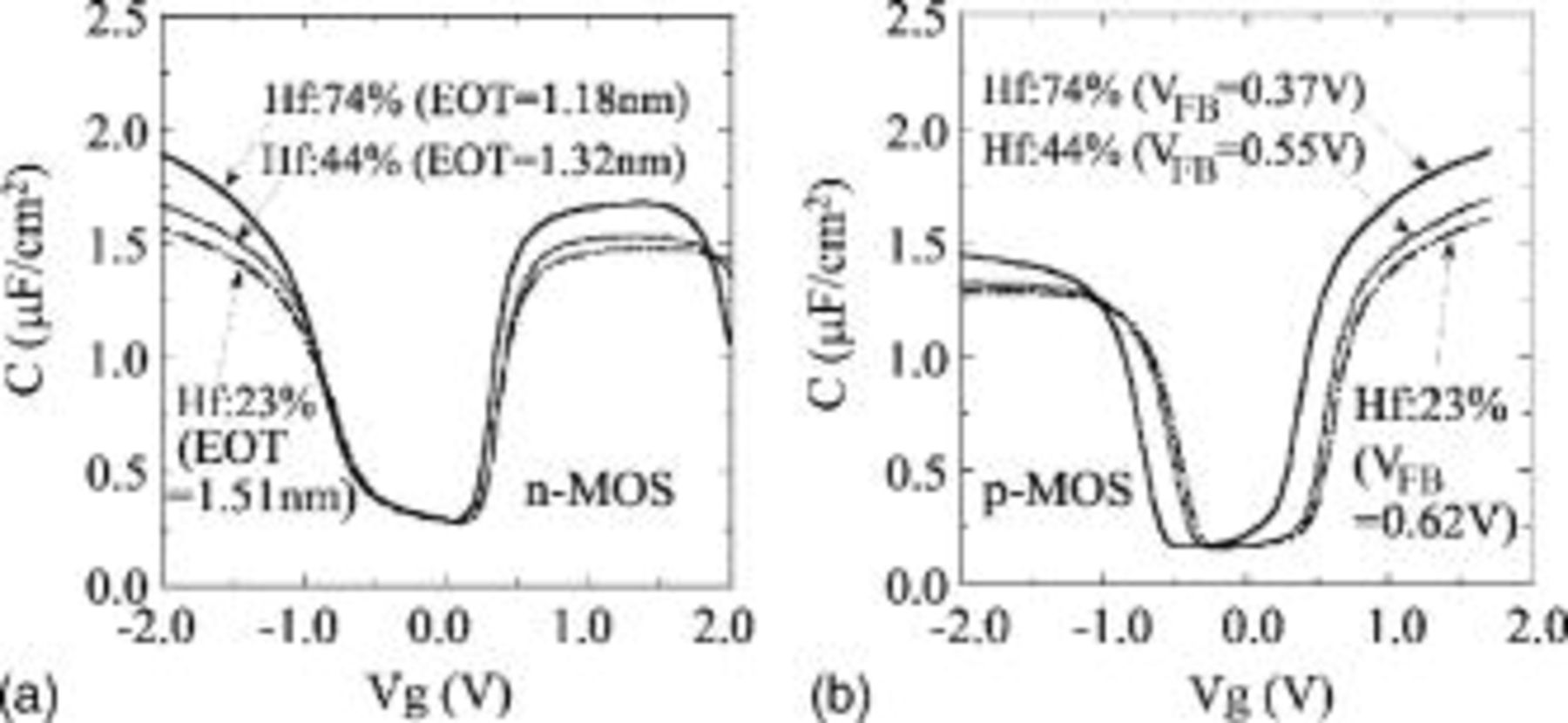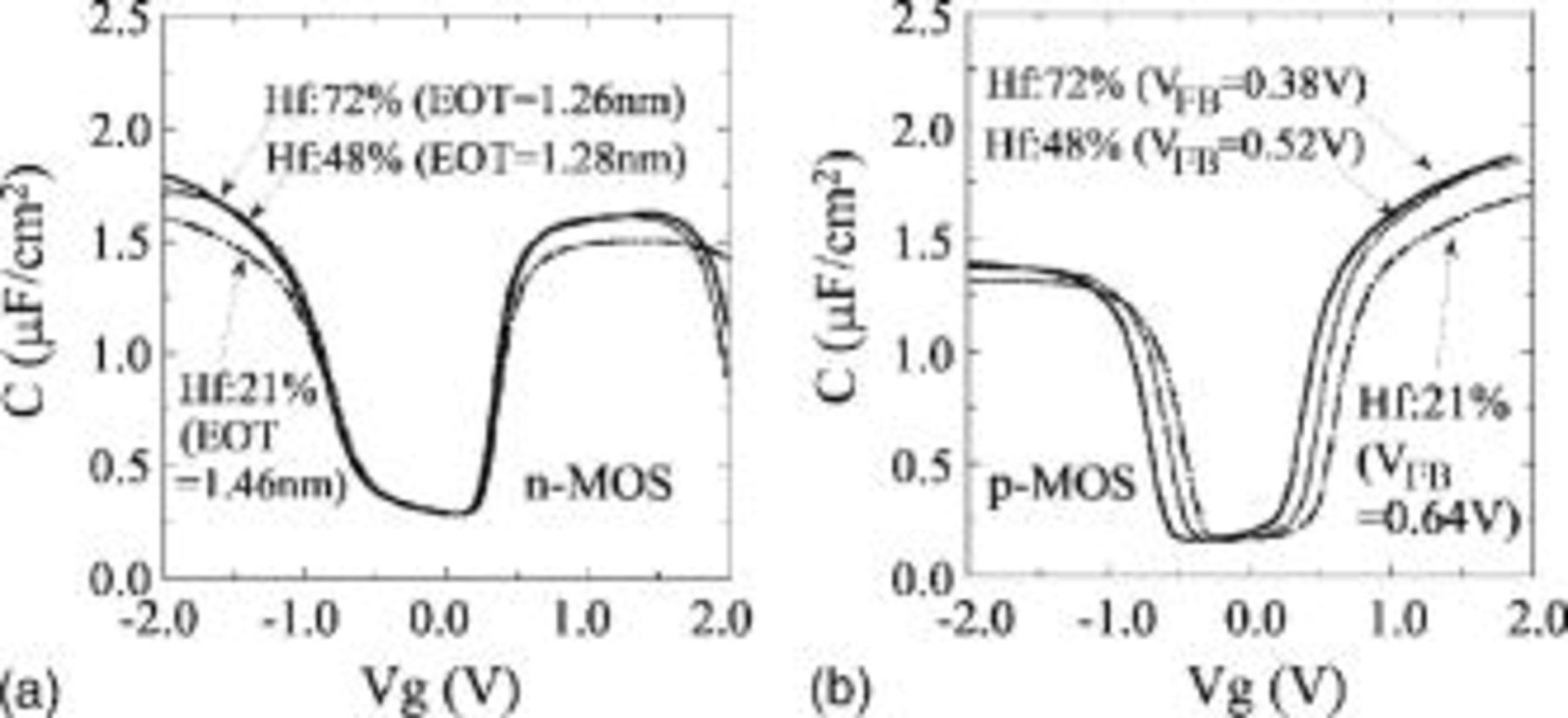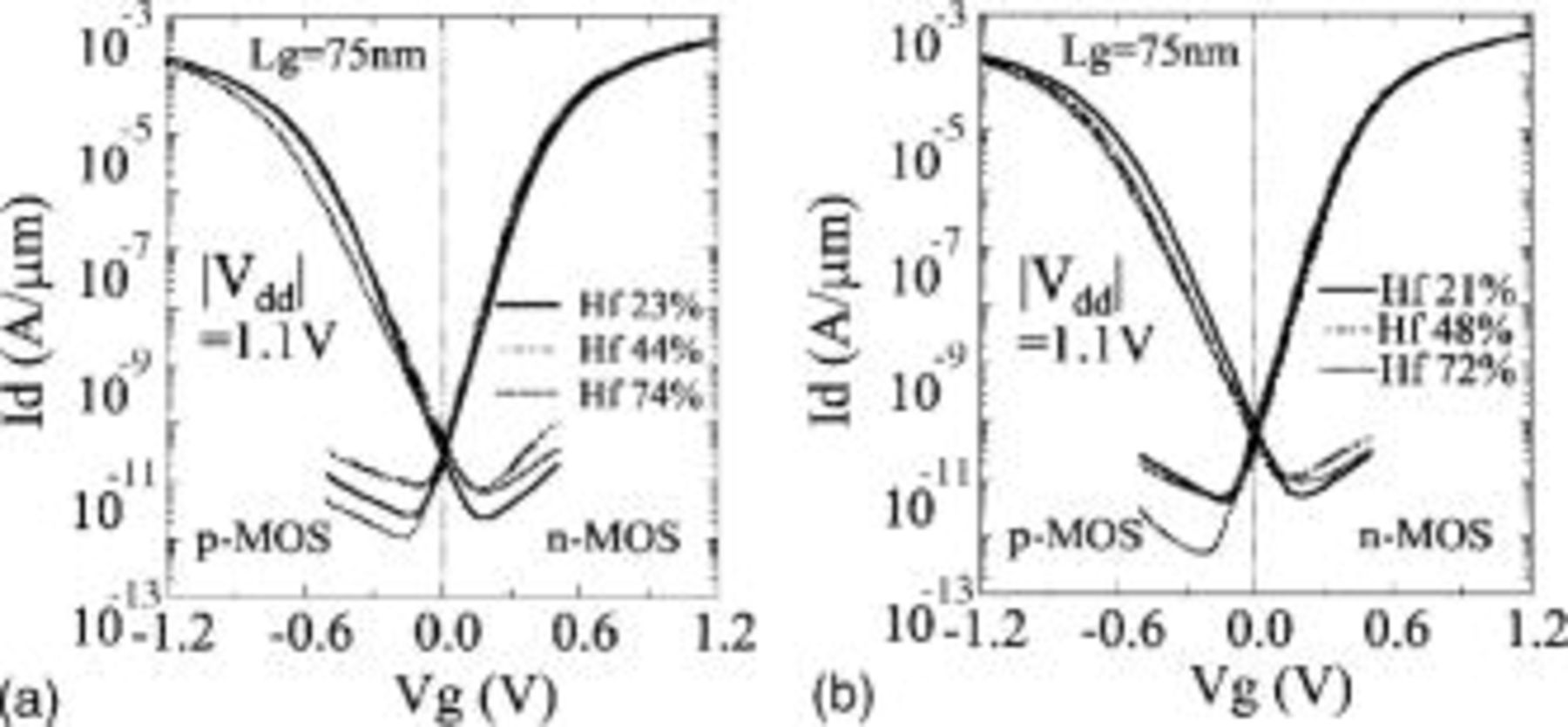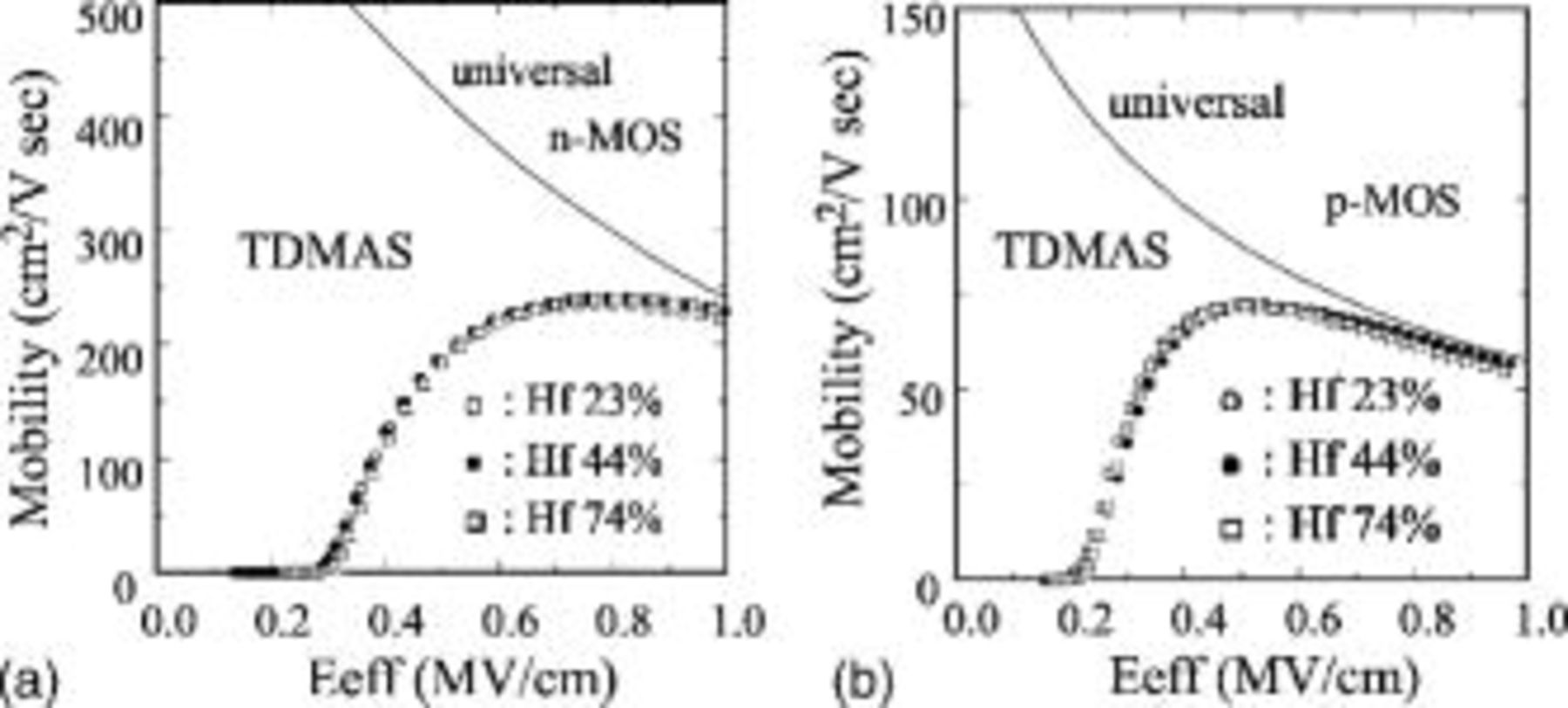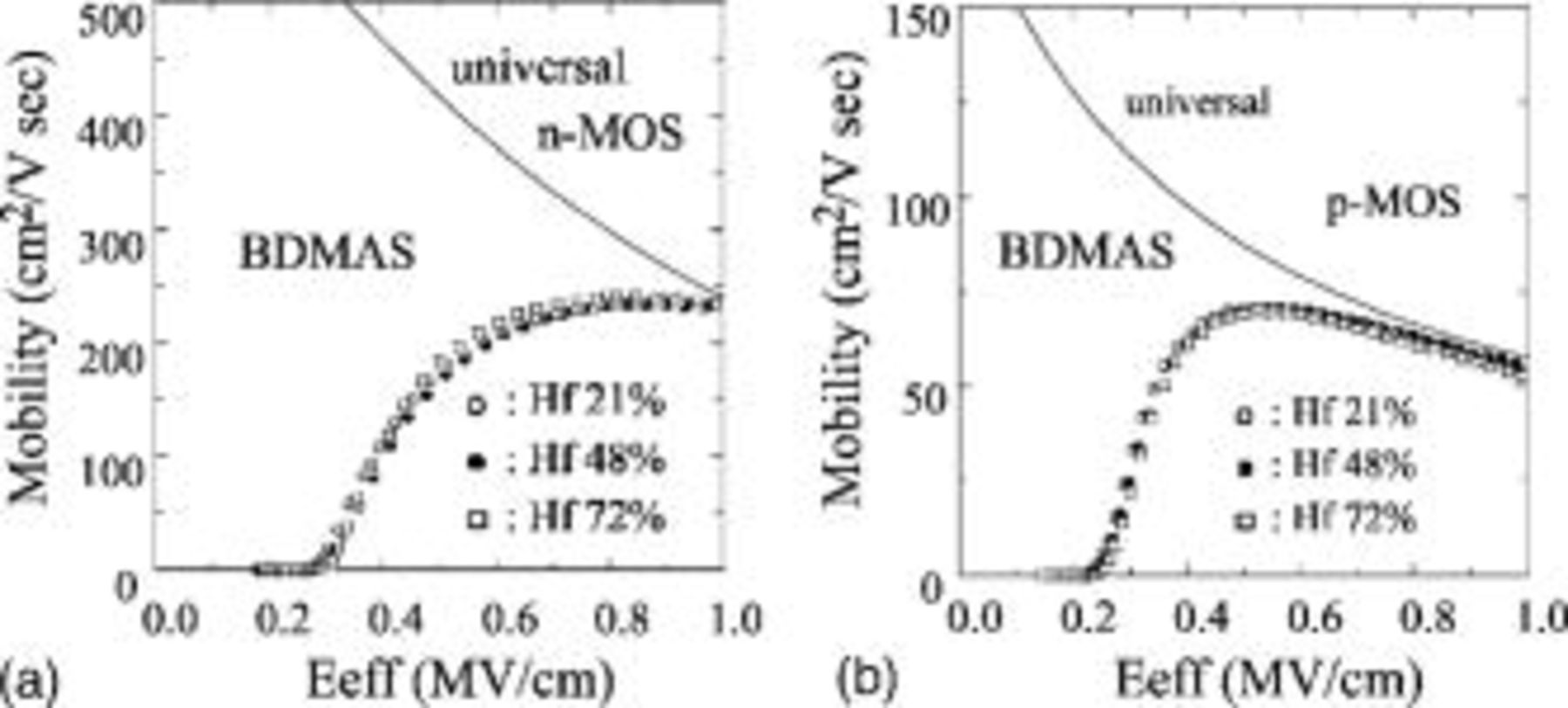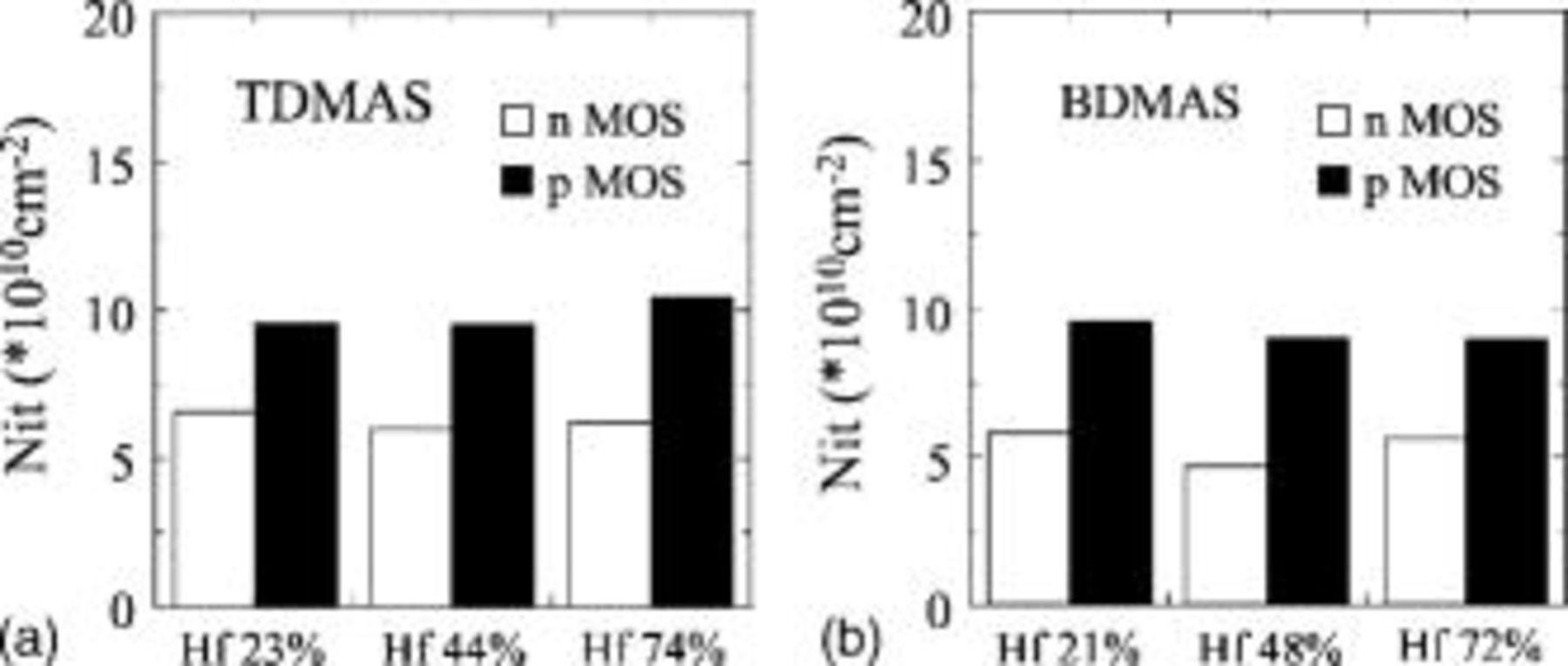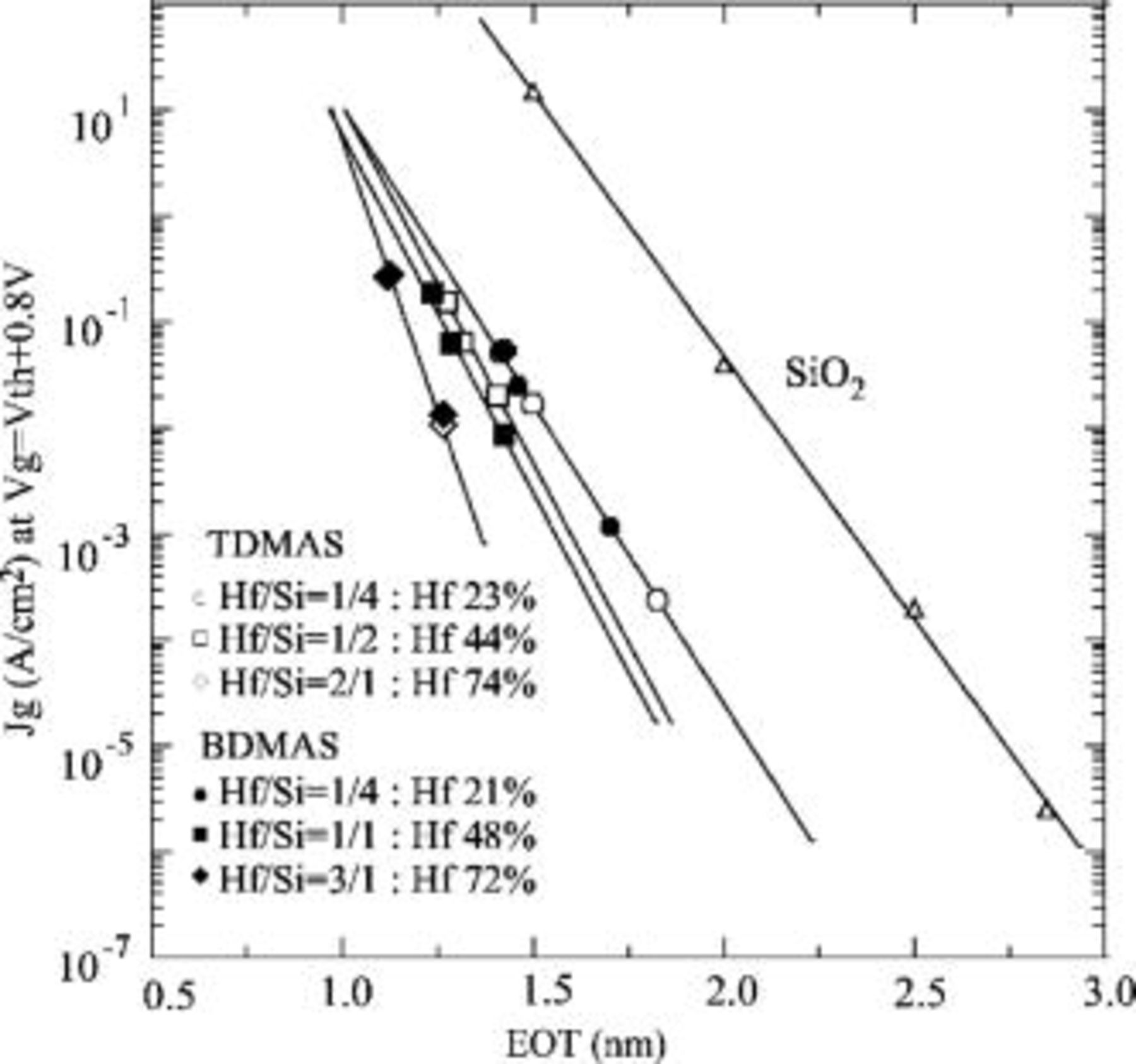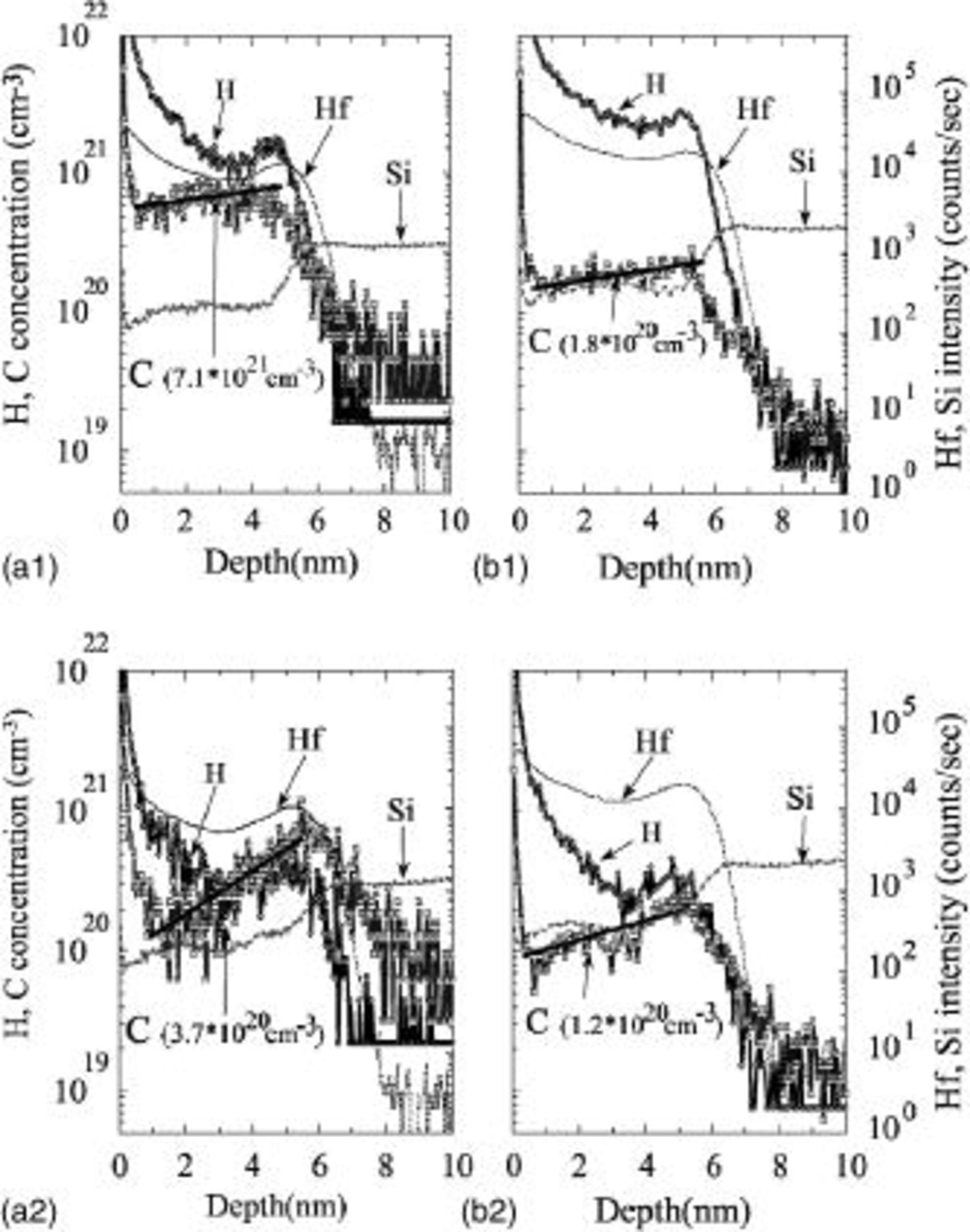Abstract
We studied the electrical properties of polysilicon/hafnium (Hf)-silicate gate stacks with various controlled  compositions, using bis-dimethylamino-silane (BDMAS:
compositions, using bis-dimethylamino-silane (BDMAS:  ) and tris-dimethylamino-silane (TDMAS:
) and tris-dimethylamino-silane (TDMAS:  ) as precursors. The high-
) as precursors. The high- films were fabricated by atomic layer deposition (ALD) using
films were fabricated by atomic layer deposition (ALD) using  and each of the Si precursors in turn.
and each of the Si precursors in turn.  was used as an oxidant. Effective oxide thicknesses (EOTs) were reduced in line with increasing Hf contents: the very thin dielectric
was used as an oxidant. Effective oxide thicknesses (EOTs) were reduced in line with increasing Hf contents: the very thin dielectric  was fabricated with a
was fabricated with a  composition of 74%. The flatband voltage
composition of 74%. The flatband voltage  shift of p-type metal oxide semiconductor field effect transistors (p-MOSFETs) employing either Si precursor were improved by reducing the
shift of p-type metal oxide semiconductor field effect transistors (p-MOSFETs) employing either Si precursor were improved by reducing the  composition: the value of
composition: the value of  shift was improved to about
shift was improved to about  for Hf-silicate gate stacks in which
for Hf-silicate gate stacks in which  composition was reduced from 72–74% to 21–23%. The subthreshold swings (S values) were dependent on the Hf content in the p-MOSFETs employing both Si precursors. By using the gate length (Lg) of the transistors as
composition was reduced from 72–74% to 21–23%. The subthreshold swings (S values) were dependent on the Hf content in the p-MOSFETs employing both Si precursors. By using the gate length (Lg) of the transistors as  ,
,  values varied from
values varied from  /dec for
/dec for  composition ratios from 21 to 74%, respectively, due to a Fermi-level pinning problem. Inspection of subthreshold characteristics of n-MOSFETs revealed values of
composition ratios from 21 to 74%, respectively, due to a Fermi-level pinning problem. Inspection of subthreshold characteristics of n-MOSFETs revealed values of  at
at  , which were greater than
, which were greater than  , while
, while  was less than
was less than  , using either Si precursor
, using either Si precursor  . With the p-MOSFETs, the values of
. With the p-MOSFETs, the values of  at
at  for Hf-silicate gate stacks in which
for Hf-silicate gate stacks in which  composition was between 21 and 23% were approximately
composition was between 21 and 23% were approximately  greater than those in which
greater than those in which  composition was between 72 and 74%. The leakage current densities were dependent on the Hf content in the Hf-silicate gate stacks. However, those were independent of the Si precursors for the Hf-silicate gate stacks with the same Hf content, because the carbon impurity concentrations near the surface of the annealed layers at
composition was between 72 and 74%. The leakage current densities were dependent on the Hf content in the Hf-silicate gate stacks. However, those were independent of the Si precursors for the Hf-silicate gate stacks with the same Hf content, because the carbon impurity concentrations near the surface of the annealed layers at  were about
were about  for both Si precursors.
for both Si precursors.
Export citation and abstract BibTeX RIS
For many years, silicon dioxide  films have been the gate dielectric in complementary metal oxide semiconductor (CMOS) devices. For gate oxide thicknesses of less than
films have been the gate dielectric in complementary metal oxide semiconductor (CMOS) devices. For gate oxide thicknesses of less than  , the direct tunneling current increases by a factor of 100 times for each
, the direct tunneling current increases by a factor of 100 times for each  decrease in thickness.1, 2 This high gate leakage current increases the standby power consumption.2 In order to reduce the leakage current due to direct tunneling, high-dielectric-constant (high-
decrease in thickness.1, 2 This high gate leakage current increases the standby power consumption.2 In order to reduce the leakage current due to direct tunneling, high-dielectric-constant (high- ) materials allow for an increase in the physical thickness while maintaining a low equivalent oxide thickness.3–8 Among the many high-
) materials allow for an increase in the physical thickness while maintaining a low equivalent oxide thickness.3–8 Among the many high- materials available, those based on Hf and its nitride exhibit low leakage currents and high carrier mobility.7, 8
materials available, those based on Hf and its nitride exhibit low leakage currents and high carrier mobility.7, 8
Sputtering and metallorganic chemical vapor deposition (MOCVD) are two methods that have been used for the formation of high- films.3–8 Another possible deposition technique is atomic layer deposition (ALD), which has some desirable features in that it allows precise control of composition, film thickness, conformality, and uniformity.9–15 Hafnium-tetrachloride
films.3–8 Another possible deposition technique is atomic layer deposition (ALD), which has some desirable features in that it allows precise control of composition, film thickness, conformality, and uniformity.9–15 Hafnium-tetrachloride  and water
and water  have been widely used to deposit
have been widely used to deposit  using the ALD technique.9, 10 There have been reports of groups using Hf amide-type precursors such as
using the ALD technique.9, 10 There have been reports of groups using Hf amide-type precursors such as  for growing
for growing  or Hf-aluminate films in order to solve the problem of particles that occurs when using
or Hf-aluminate films in order to solve the problem of particles that occurs when using  precursors.11–16 Furthermore,
precursors.11–16 Furthermore,  and
and  precursors are interesting materials because their melting points are very low (less than
precursors are interesting materials because their melting points are very low (less than  ) and they exhibit high vapor pressures (92 and
) and they exhibit high vapor pressures (92 and  at
at  , respectively).15, 16 It has been reported that the thickness and
, respectively).15, 16 It has been reported that the thickness and  composition ratios of ALD Hf-silicate films could be easily controlled by regulating the number of deposition cycles using
composition ratios of ALD Hf-silicate films could be easily controlled by regulating the number of deposition cycles using  and TDMAS
and TDMAS  , or
, or  and BDMAS
and BDMAS  precursors.15, 16 The flatband/threshold voltage
precursors.15, 16 The flatband/threshold voltage  of poly-Si gated p-type metal oxide semiconductor field effect transistor (p-MOSFETs) formed using Hf-based gate dielectrics is unacceptably high due to Fermi-level pinning.17 Recently, the suppression of these shifts in
of poly-Si gated p-type metal oxide semiconductor field effect transistor (p-MOSFETs) formed using Hf-based gate dielectrics is unacceptably high due to Fermi-level pinning.17 Recently, the suppression of these shifts in  has been studied for Si-rich Hf-silicate gate dielectrics
has been studied for Si-rich Hf-silicate gate dielectrics  in poly-Si gated p-MOSFETs.17–20
in poly-Si gated p-MOSFETs.17–20
In this study, we investigated the effect of  composition on the electrical properties of poly-Si gated n- and p-MOSFETs, incorporating ALD Hf-silicate gate dielectrics that had been fabricated using
composition on the electrical properties of poly-Si gated n- and p-MOSFETs, incorporating ALD Hf-silicate gate dielectrics that had been fabricated using  and TDMAS, or
and TDMAS, or  and BDMAS precursors.
and BDMAS precursors.
Experimental
The substrates that we used were  p-type Si(100) wafers. Immediately following a pretreatment with diluted (0.5%) HF, a
p-type Si(100) wafers. Immediately following a pretreatment with diluted (0.5%) HF, a  -thick SiON layer was formed by rapid thermal processing (RTP) in an NO ambient at
-thick SiON layer was formed by rapid thermal processing (RTP) in an NO ambient at  for
for  to prevent boron penetration and interfacial layer growth. After the underlayer formation, Hf-silicate films were deposited by using an ALD technique.
to prevent boron penetration and interfacial layer growth. After the underlayer formation, Hf-silicate films were deposited by using an ALD technique.  was used to form the
was used to form the  layers, and TDMAS or BDMAS were used to form the
layers, and TDMAS or BDMAS were used to form the  layers. A single ALD cycle for
layers. A single ALD cycle for  consisted of the following process: the
consisted of the following process: the  precursor was introduced into the reactor chamber for
precursor was introduced into the reactor chamber for  , after which it was purged for
, after which it was purged for  . This precursor was introduced using a liquid flow meter system and vaporized at
. This precursor was introduced using a liquid flow meter system and vaporized at  with Ar as a carrier gas. Following this,
with Ar as a carrier gas. Following this,  was introduced for
was introduced for  as an oxidant and then purged for
as an oxidant and then purged for  . The
. The  and the carrier gas had flow rates of
and the carrier gas had flow rates of  and
and  , respectively. A single ALD cycle for
, respectively. A single ALD cycle for  consisted of the following process: the Si precursor was introduced into the reactor chamber for
consisted of the following process: the Si precursor was introduced into the reactor chamber for  and was then purged for
and was then purged for  , and an oxidant
, and an oxidant  was introduced for
was introduced for  and purged for
and purged for  . In this ALD
. In this ALD  process, BDMAS was directly introduced into the reactor chamber and controlled using a mass flow system at
process, BDMAS was directly introduced into the reactor chamber and controlled using a mass flow system at  , because the vapor pressure of BDMAS is very high. The BDMAS had a flow rate of
, because the vapor pressure of BDMAS is very high. The BDMAS had a flow rate of  in order to obtain good uniformity of better than 5%. TDMAS was introduced into the reactor chamber using a liquid mass flow system and vaporized at
in order to obtain good uniformity of better than 5%. TDMAS was introduced into the reactor chamber using a liquid mass flow system and vaporized at  with Ar as a carrier gas. The TDMAS and carrier gas have flow rates of 10 and
with Ar as a carrier gas. The TDMAS and carrier gas have flow rates of 10 and  , respectively, to obtain good uniformity of better than 5%. In the process, a buffer gas of Ar always flowed at
, respectively, to obtain good uniformity of better than 5%. In the process, a buffer gas of Ar always flowed at  into the reactor chamber.
into the reactor chamber.  was used as a source of oxygen using an
was used as a source of oxygen using an  flow ratio of
flow ratio of  with the concentration of
with the concentration of  in
in  being
being  . The pressure in the ALD reactor chamber was controlled at
. The pressure in the ALD reactor chamber was controlled at  for
for  deposition, and at
deposition, and at  and
and  for TDMAS-
for TDMAS- and BDMAS-
and BDMAS- deposition, respectively.15, 16 The film depositions were carried out at
deposition, respectively.15, 16 The film depositions were carried out at  . The
. The  compositions of the ALD Hf-silicate films were controlled by varying the
compositions of the ALD Hf-silicate films were controlled by varying the  ratio in the gas-phase: compositions of 23, 44, and 74% were achieved for ratios of
ratio in the gas-phase: compositions of 23, 44, and 74% were achieved for ratios of  ,
,  , and
, and  for TDMAS; and 21, 48, and 72% were achieved for ratios of
for TDMAS; and 21, 48, and 72% were achieved for ratios of  ,
,  , and
, and  for BDMAS, respectively.15, 16
for BDMAS, respectively.15, 16
In this transistor device fabrication process, counterimplantation was applied to reduce the  for p-MOSFETs after the well formation.21 The channel doping concentrations were about 5 and
for p-MOSFETs after the well formation.21 The channel doping concentrations were about 5 and  for n-MOS and p-MOSFETs, respectively. After the formation of high-
for n-MOS and p-MOSFETs, respectively. After the formation of high- gate stack dielectrics, the films were nitrided using a nitrogen radical plasma treatment.8 The nitrogen plasma was formed in an
gate stack dielectrics, the films were nitrided using a nitrogen radical plasma treatment.8 The nitrogen plasma was formed in an  ambient at
ambient at  at
at  using a
using a  radio frequency (rf) power supply. After nitridation, the films were treated in an
radio frequency (rf) power supply. After nitridation, the films were treated in an  -diluted oxygen atmosphere (
-diluted oxygen atmosphere ( concentration of 0.1%) at
concentration of 0.1%) at  for
for  as a postnitridation annealing (PNA). Polysilicon was then deposited on the high-
as a postnitridation annealing (PNA). Polysilicon was then deposited on the high- gate stack to provide the gate electrodes, and boron and phosphorus were implanted as p- and n-type dopants, respectively. After patterning and etching of the polysilicon gate electrodes, rapid thermal annealing (RTA) was performed at
gate stack to provide the gate electrodes, and boron and phosphorus were implanted as p- and n-type dopants, respectively. After patterning and etching of the polysilicon gate electrodes, rapid thermal annealing (RTA) was performed at  for
for  to activate the dopants. The samples were then annealed at
to activate the dopants. The samples were then annealed at  for
for  in forming gas (
in forming gas ( mixture).
mixture).
The film thickness and uniformity of the Hf-silicate and  films were measured with an ellipsometer over
films were measured with an ellipsometer over  wafers. The composition of the Hf-silicate films was measured using high-resolution Rutherford backscattering (HR-RBS) analysis with a
wafers. The composition of the Hf-silicate films was measured using high-resolution Rutherford backscattering (HR-RBS) analysis with a  helium ion
helium ion  beam. Capacitance-voltage (C-V) and current-voltage (I-V) measurements were performed in parallel on an HP 4284A LCR meter at high frequency
beam. Capacitance-voltage (C-V) and current-voltage (I-V) measurements were performed in parallel on an HP 4284A LCR meter at high frequency  and an HP 4156C parameter analyzer. The effective oxide thicknesses (EOT) and flatband voltage
and an HP 4156C parameter analyzer. The effective oxide thicknesses (EOT) and flatband voltage  of the films were calculated using an analytical quantum mechanical model.22 The effective mobility was measured by applying a modified split C-V method. The interfacial trap density (Nit) was evaluated from the charge-pumping current (Icp) at room temperature.14 Residual impurities such as carbon and hydrogen were analyzed by secondary ion mass spectrometry (SIMS) with a
of the films were calculated using an analytical quantum mechanical model.22 The effective mobility was measured by applying a modified split C-V method. The interfacial trap density (Nit) was evaluated from the charge-pumping current (Icp) at room temperature.14 Residual impurities such as carbon and hydrogen were analyzed by secondary ion mass spectrometry (SIMS) with a  cesium primary ion
cesium primary ion  beam. The primary ion beam was raster scanned over an area of
beam. The primary ion beam was raster scanned over an area of  .
.
Results and Discussion
Figure 1 shows the C-V characteristics of ALD Hf-silicate gate stacks employing TDMAS for (a) n-MOSFETs and (b) p-MOSFETs. Hf-silicate films were evaluated with three different Hf contents (Hf 74% using  , Hf 44% using
, Hf 44% using  , and Hf 23% using
, and Hf 23% using  ratio). As shown in Fig. 1, the EOTs of these films were 1.18, 1.32, and
ratio). As shown in Fig. 1, the EOTs of these films were 1.18, 1.32, and  for
for  compositions of 74, 44, and 23%, respectively, in the Hf-silicate gate stacks: the EOTs were reduced with increasing Hf contents due to increases in their dielectric constant
compositions of 74, 44, and 23%, respectively, in the Hf-silicate gate stacks: the EOTs were reduced with increasing Hf contents due to increases in their dielectric constant  . The
. The  of all of the n-MOSFETs were almost the same, however, those of the p-MOSFETs were dependent on the Hf content of the Hf-silicate gate stacks.
of all of the n-MOSFETs were almost the same, however, those of the p-MOSFETs were dependent on the Hf content of the Hf-silicate gate stacks.
Figure 1. C-V characteristics of ALD Hf-silicate gate stacks employing TDMAS for (a) n-MOSFETs and (b) p-MOSFETs. Hf-silicate films were evaluated with three different Hf contents (Hf 74% using  , Hf 44% using
, Hf 44% using  , and Hf 23% using
, and Hf 23% using  ratios). C-V measurements were performed using capacitors with an area of
ratios). C-V measurements were performed using capacitors with an area of 
 . The EOT and flatband voltage
. The EOT and flatband voltage  were calculated from the analytical quantum mechanical model.22
were calculated from the analytical quantum mechanical model.22
Figure 2 shows the C-V characteristics of ALD Hf-silicate gate stacks employing BDMAS for (a) n-MOSFETs and (b) p-MOSFETs. The Hf-silicate films possessed almost the same Hf contents as in the TDMAS case; the  compositions of 72, 48, and 21% were achieved with ratios of
compositions of 72, 48, and 21% were achieved with ratios of  ,
,  , and
, and  , respectively. As shown in Fig. 2, the values of EOT were reduced with increasing Hf contents and the
, respectively. As shown in Fig. 2, the values of EOT were reduced with increasing Hf contents and the  values of the p-MOSFETs were also dependent on the Hf contents of the Hf-silicate gate stacks.
values of the p-MOSFETs were also dependent on the Hf contents of the Hf-silicate gate stacks.
Figure 2. C-V characteristics of ALD Hf-silicate gate stacks employing BDMAS for (a) n-MOSFETs and (b) p-MOSFETs. Hf-silicate films were evaluated with three different HF contents (Hf 72% using  , Hf 48% using
, Hf 48% using  , and Hf 21% using
, and Hf 21% using  ratios).
ratios).
Figure 3 shows the dependence of  on the
on the  composition in the ALD Hf-silicate gate stacks, using TDMAS and BDMAS precursors, for n- and p-MOSFETs. As shown in Fig. 3, values of
composition in the ALD Hf-silicate gate stacks, using TDMAS and BDMAS precursors, for n- and p-MOSFETs. As shown in Fig. 3, values of  of n-MOSFETs were slightly increased by reducing the
of n-MOSFETs were slightly increased by reducing the  composition: the value of
composition: the value of  shift was about
shift was about  . Values of
. Values of  shift of p-MOSFETs were improved by reducing the
shift of p-MOSFETs were improved by reducing the  composition: the improved value of
composition: the improved value of  shift was about
shift was about  for
for  compositions of 23–21%. Furthermore, these results were not dependent on the Si precursors. This probably occurs because the Fermi-level pinning problem is suppressed by Si-rich Hf-silicate films; however, there is still the Fermi-level pinning problem because the value of
compositions of 23–21%. Furthermore, these results were not dependent on the Si precursors. This probably occurs because the Fermi-level pinning problem is suppressed by Si-rich Hf-silicate films; however, there is still the Fermi-level pinning problem because the value of  is about
is about  for the poly-
for the poly- sample using the same conditions of device fabrication process.17–20 The reason for this result is still not fully understood.
sample using the same conditions of device fabrication process.17–20 The reason for this result is still not fully understood.
Figure 3. Dependence of  on the
on the  composition in the ALD Hf-silicate gate stacks, using TDMAS and BDMAS precursors, for n- and p-MOSFETs.
composition in the ALD Hf-silicate gate stacks, using TDMAS and BDMAS precursors, for n- and p-MOSFETs.
Figure 4 shows the subthreshold characteristics of ALD Hf-silicate gate stacks with different Hf contents using (a) TDMAS and (b) BDMAS precursors. In this measurement, the gate length (Lg) and the gate width  of the transistors used were
of the transistors used were  and
and  , and the applied voltages between the drain and the source were 1.1 and
, and the applied voltages between the drain and the source were 1.1 and  for the n- and p-MOSFETs, respectively. The subthreshold swings (
for the n- and p-MOSFETs, respectively. The subthreshold swings ( values) for all samples were good, being less than
values) for all samples were good, being less than  /dec for n-MOSFETs. The S values were dependent on the Hf content of Hf-silicate gate stacks for p-MOSFETs: these varied from
/dec for n-MOSFETs. The S values were dependent on the Hf content of Hf-silicate gate stacks for p-MOSFETs: these varied from  /dec for
/dec for  compositions from 21 to 74%, respectively. The drain currents
compositions from 21 to 74%, respectively. The drain currents  at
at  were less than
were less than  in both n- and p-MOSFETs. The drain current
in both n- and p-MOSFETs. The drain current  at
at  in the n-MOSFETs fabricated using BDMAS were larger than those using TDMAS because the values of
in the n-MOSFETs fabricated using BDMAS were larger than those using TDMAS because the values of  of BDMAS devices were slightly larger than those using TDMAS. The values of
of BDMAS devices were slightly larger than those using TDMAS. The values of  were greater than about
were greater than about  . Meanwhile, the values of
. Meanwhile, the values of  in the p-MOSFET samples were dependent on the Hf-content. The values of
in the p-MOSFET samples were dependent on the Hf-content. The values of  for Hf-silicate gate stacks containing
for Hf-silicate gate stacks containing  compositions of 72–74% were about
compositions of 72–74% were about  less than the values in devices with
less than the values in devices with  compositions of 21–23%, probably due to the Fermi-level pinning problem. The processing parameters and electrical properties of these samples are summarized in Table I.
compositions of 21–23%, probably due to the Fermi-level pinning problem. The processing parameters and electrical properties of these samples are summarized in Table I.
Figure 4. Subthreshold characteristics of ALD Hf-silicate gate stacks with different Hf contents, using (a) TDMAS and (b) BDMAS precursors. In this (Lg) and the gate width  of the transistors used were
of the transistors used were  and
and  , and the applied voltages between the drain and the source were 1.1 and
, and the applied voltages between the drain and the source were 1.1 and  for the n- and p-MOSFETs, respectively. The value of the threshold voltage was defined as the gate voltage for
for the n- and p-MOSFETs, respectively. The value of the threshold voltage was defined as the gate voltage for  for n- and p-MOSFETs.
for n- and p-MOSFETs.
Table I. Processing parameters and electrical properties of ALD Hf-silicate gate stacks using TDMAS and BDMAS precursors.
| Si Precorsors |
 ratio ratio |
 composition composition |
  at at 
|
  at at 
| S (mV/dec.) | |||
|---|---|---|---|---|---|---|---|---|
| n-MOS | p-MOS | n-MOS | p-MOS | p-MOS | p-MOS | |||

| 23% | 320 | 152 | 20 | 30 | 74 | 92 | |
| TDMAS |

| 44% | 352 | 155 | 26 | 60 | 72 | 96 |

| 74% | 340 | 118 | 29 | 45 | 71 | 102 | |

| 21% | 379 | 159 | 52 | 62 | 75 | 94 | |
| BDMAS |

| 48% | 389 | 134 | 31 | 43 | 73 | 99 |

| 72% | 390 | 115 | 74 | 66 | 74 | 105 | |
Figure 5 shows the effective mobility curves of ALD Hf-silicate gate stacks employing TDMAS for (a) n-MOSFETs and (b) p-MOSFETs. Universal curves are shown for reference. Hf-silicate films were evaluated with three different Hf contents (Hf 74% using  , Hf 44% using
, Hf 44% using  , and Hf 23% using
, and Hf 23% using  ratio). The effective mobility was measured by applying a modified split C-V method. As shown in Fig. 5, the effective curves were good for both n-MOS and p-MOSFETs, being the same level as that of reference universal curves at
ratio). The effective mobility was measured by applying a modified split C-V method. As shown in Fig. 5, the effective curves were good for both n-MOS and p-MOSFETs, being the same level as that of reference universal curves at  . Furthermore, the effective mobility curves did not vary between the Hf contents [
. Furthermore, the effective mobility curves did not vary between the Hf contents [ 23–74%] for either n-MOS and p-MOSFETs.
23–74%] for either n-MOS and p-MOSFETs.
Figure 5. Effective mobility curves of ALD Hf-silicate gate stacks employing TDMAS for (a) n-MOSFETs and (b) p-MOSFETs. Universal curves are shown for reference. Hf-silicate films were evaluated with three different Hf contents (Hf 74% using  , Hf 44% using
, Hf 44% using  , and Hf 23% using
, and Hf 23% using  ratio). The effective mobility was measured by applying a modified split C-V method.
ratio). The effective mobility was measured by applying a modified split C-V method.
Figure 6 shows the effective mobility curves of ALD Hf-silicate gate stacks employing BDMAS for (a) n-MOSFETs and (b) p-MOSFETs. Hf-silicate films were evaluated with three different Hf contents (Hf 72% using  , Hf 48% using
, Hf 48% using  , and Hf 21% using
, and Hf 21% using  ratio). The effective curves were good for both n-MOS and p-MOSFETs, and the effective mobility curves did not vary between the Hf contents (
ratio). The effective curves were good for both n-MOS and p-MOSFETs, and the effective mobility curves did not vary between the Hf contents ( 21–72%) for either n-MOS or p-MOSFETs. Also, the effective mobility curves of Hf-silicate gate stacks employing BDMAS were almost the same as those employing TDMAS (Fig. 5) for all of the n-MOS and p-MOSFETs.
21–72%) for either n-MOS or p-MOSFETs. Also, the effective mobility curves of Hf-silicate gate stacks employing BDMAS were almost the same as those employing TDMAS (Fig. 5) for all of the n-MOS and p-MOSFETs.
Figure 6. Effective mobility curves of ALD Hf-silicate gate stacks employing BDMAS for (a) n-MOSFETs and (b) p-MOSFETs. Hf-silicate films were evaluated with three different Hf contents (Hf 72% using  , Hf 48% using
, Hf 48% using  , and Hf 21% using
, and Hf 21% using  ratio).
ratio).
Figure 7 shows the number of interface trap density (Nit) of ALD Hf-silicate gate stacks employing (a) TDMAS and (b) BDMAS for both n-MOS and p-MOSFETs. As shown in Fig. 7, the interface trap densities for all n-MOSFET devices were low, despite using high- gate stacks. Trap densities of about
gate stacks. Trap densities of about  for all n-MOSFETs were almost the same level as those with the
for all n-MOSFETs were almost the same level as those with the  SiON reference film.14, 23 Therefore, the effective mobility curves did not vary between the Hf contents [
SiON reference film.14, 23 Therefore, the effective mobility curves did not vary between the Hf contents [ 21–74%] and using TDMAS and BDMAS precursors for n-MOSFETs. However, the interface trap densities for all p-MOSFET devices were higher than those with the
21–74%] and using TDMAS and BDMAS precursors for n-MOSFETs. However, the interface trap densities for all p-MOSFET devices were higher than those with the  SiON reference film. For p-MOSFETs, the effective mobility is not so sensitive to the interface trap density, so the effective mobility is not changed for all ALD Hf-silicate gate stacks employing TDMAS and BDMAS precursors (Fig. 5 and 6).
SiON reference film. For p-MOSFETs, the effective mobility is not so sensitive to the interface trap density, so the effective mobility is not changed for all ALD Hf-silicate gate stacks employing TDMAS and BDMAS precursors (Fig. 5 and 6).
Figure 7. Interface trap density (Nit) of ALD Hf-silicate gate stacks employing (a) TDMAS and (b) BDMAS for both n-MOS and p-MOSFETs. Nit was evaluated from the charge-pumping current (Icp) at room temperature. In this measurement, the gate length (Lg) and the gate width  used were 0.5 and
used were 0.5 and  , respectively.
, respectively.
Figure 8 shows the leakage current density at  as a function of EOT for n-MOSFETs. Thermal oxide data is also given for reference. The I-V measurements were performed using capacitors with an area of
as a function of EOT for n-MOSFETs. Thermal oxide data is also given for reference. The I-V measurements were performed using capacitors with an area of 
 . The leakage current density in Hf-silicate gate stacks with
. The leakage current density in Hf-silicate gate stacks with  were reduced by about 3 orders of the magnitude with respect to a reference
were reduced by about 3 orders of the magnitude with respect to a reference  film. Furthermore, the leakage current densities were dependent on the Hf content of the Hf-silicate gate stacks: the leakage current densities were reduced as the Hf content increased because all of the devices were fabricated with same thickness, resulting in thinner EOTs. Furthermore, the leakage current densities were not dependent on the Si precursors.
film. Furthermore, the leakage current densities were dependent on the Hf content of the Hf-silicate gate stacks: the leakage current densities were reduced as the Hf content increased because all of the devices were fabricated with same thickness, resulting in thinner EOTs. Furthermore, the leakage current densities were not dependent on the Si precursors.
Figure 8. Leakage current density at  as a function of EOT for n-MOSFETs. I-V measurements were performed using capacitors with an area of
as a function of EOT for n-MOSFETs. I-V measurements were performed using capacitors with an area of 
 .
.
Figure 9 shows SIMS depth profiles of ALD Hf-silicate films using (a) TDMAS and (b) BDMAS precursors. In these results, a  ratio of 1:1 was used in each ALD Hf-silicate film formation, and all the films were deposited at
ratio of 1:1 was used in each ALD Hf-silicate film formation, and all the films were deposited at  . The
. The  compositions of the Hf-silicate films were 56 and 48% using TDMAS and BDMAS, respectively. As can be seen in Fig. 9a-1, the average residual carbon impurity concentrations in the as-deposited layer using TDMAS were
compositions of the Hf-silicate films were 56 and 48% using TDMAS and BDMAS, respectively. As can be seen in Fig. 9a-1, the average residual carbon impurity concentrations in the as-deposited layer using TDMAS were  . For ALD Hf-silicate film formation using BDMAS (as shown in Fig. 9a-2), the carbon impurity concentrations were reduced by about an order of magnitude with respect to the process using TDMAS. As shown in Fig. 9b-1 and 9b-2, the average residual carbon impurity concentrations in the annealed layer, using both Si precursors, were reduced by about a half order of magnitude compared with the as-deposited layers. Furthermore, as the carbon impurity concentrations near the surface of the annealed layers were about
. For ALD Hf-silicate film formation using BDMAS (as shown in Fig. 9a-2), the carbon impurity concentrations were reduced by about an order of magnitude with respect to the process using TDMAS. As shown in Fig. 9b-1 and 9b-2, the average residual carbon impurity concentrations in the annealed layer, using both Si precursors, were reduced by about a half order of magnitude compared with the as-deposited layers. Furthermore, as the carbon impurity concentrations near the surface of the annealed layers were about  for both Si precursors, it was considered that the electrical properties would be almost the same for the Hf-silicate gate stacks with the same Hf content.
for both Si precursors, it was considered that the electrical properties would be almost the same for the Hf-silicate gate stacks with the same Hf content.
Figure 9. SIMS depth profiles of ALD Hf-silicate films using TDMAS (a) and BDMAS (b) precursors. (a-1) and (b-1) The as-deposited case, and (a-2) and (b-2) that treated by high-temperature annealing at  for
for  in
in  -diluted oxygen atmosphere (
-diluted oxygen atmosphere ( concentration of 0.1%), respectively.
concentration of 0.1%), respectively.  ratios of 1:1 were used in each ALD Hf-silicate film formation and all the films were deposited at
ratios of 1:1 were used in each ALD Hf-silicate film formation and all the films were deposited at  . SIMS analyses were done with a
. SIMS analyses were done with a  cesium primary ion
cesium primary ion  beam. The concentrations
beam. The concentrations  of carbon and hydrogen impurities are indicated by the left ordinate and the secondary ion intensities of Hf and Si (counts/s) are indicated by the right ordinate.
of carbon and hydrogen impurities are indicated by the left ordinate and the secondary ion intensities of Hf and Si (counts/s) are indicated by the right ordinate.
Conclusions
We investigated the electrical properties of poly-Si/ALD Hf-silicate gate stacks fabricated using BDMAS and TDMAS precursors. The high- films were fabricated using atomic layer deposition (ALD) employing
films were fabricated using atomic layer deposition (ALD) employing  and each of the Si precursors, in which the
and each of the Si precursors, in which the  composition was controlled. The EOTs were reduced in line with increasing Hf contents: the very thin dielectric
composition was controlled. The EOTs were reduced in line with increasing Hf contents: the very thin dielectric  was fabricated with a
was fabricated with a  composition of 74%. The
composition of 74%. The  shifts of p-MOSFETs were improved by reducing the
shifts of p-MOSFETs were improved by reducing the  composition: the value of the
composition: the value of the  shifts was improved to about
shifts was improved to about  for Hf-silicate gate stacks in which
for Hf-silicate gate stacks in which  composition was reduced from 72–74% to 21–23%. The subthreshold swings were dependent on the Hf content in the p-MOSFETs for both Si precursors.
composition was reduced from 72–74% to 21–23%. The subthreshold swings were dependent on the Hf content in the p-MOSFETs for both Si precursors.  values were varied from
values were varied from  /dec for
/dec for  compositions from 21 to 74%, respectively, due to the Fermi-level pinning problem
compositions from 21 to 74%, respectively, due to the Fermi-level pinning problem  . Inspecting the subthreshold characteristics of n-MOSFETs, the values of
. Inspecting the subthreshold characteristics of n-MOSFETs, the values of  at
at  were greater than
were greater than  and
and  was lower than
was lower than  with both Si precursors
with both Si precursors  . With p-MOSFETs, the values of
. With p-MOSFETs, the values of  at
at  for Hf-silicate gate stacks in which
for Hf-silicate gate stacks in which  was about
was about  greater than those in which
greater than those in which  . The leakage current densities were dependent on the Hf content in the Hf-silicate gate stacks. However, those were independent of the Si precursors for the Hf-silicate gate stacks with the same Hf content, because the carbon impurity concentrations near the surface of the annealed layers at
. The leakage current densities were dependent on the Hf content in the Hf-silicate gate stacks. However, those were independent of the Si precursors for the Hf-silicate gate stacks with the same Hf content, because the carbon impurity concentrations near the surface of the annealed layers at  were about
were about  for both Si precursors.
for both Si precursors.
Acknowledgment
The authors thank Dr. K. Nakamura for his encouragement and useful discussions.
Semiconductor Leading Edge Technologies (Selete), Incorporated, assisted in meeting the publication costs of this article.


